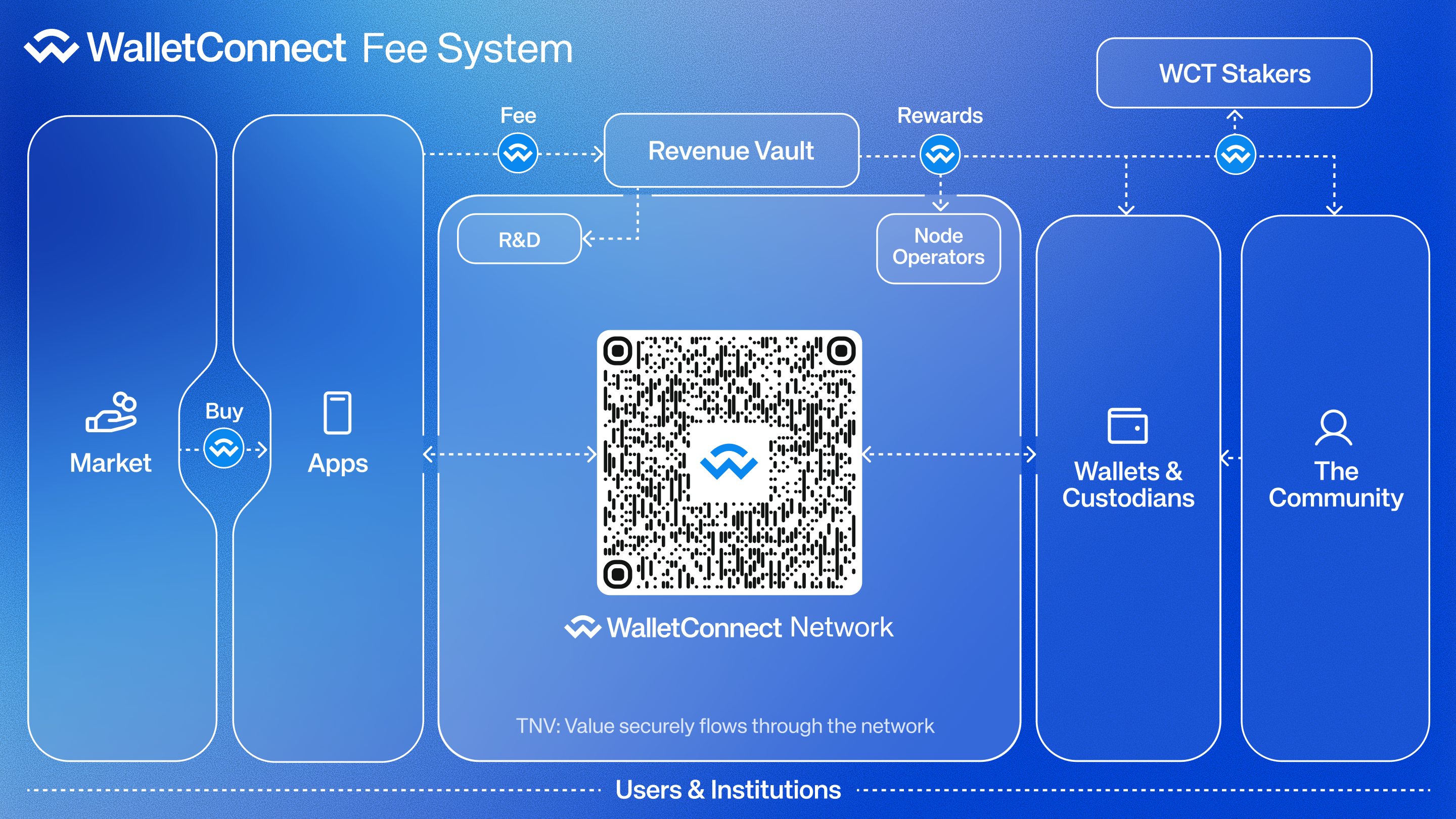Find the paper here: https://monetization.walletconnect.com/
Abstract
-WalletConnect is exploring fees, not for users, but for apps that derive value from the Network.
-Fees are still in the discovery phase as WalletConnect explores monetizing the network
-Fees are paid in WCT, creating recurring token demand.
-Collected WCT fees are redistributed to WCT stakers, wallets, custodians, node operators, and the community.
-End users will not pay to use WalletConnect. The UX remains smooth and free.
- This model aligns long-term incentives and makes the Network sustainable as it decentralizes.
1. Background/ Motivation
Since 2018, WalletConnect infrastructure has quietly powered the backbone of onchain activity, securely connecting wallets and apps across ecosystems, with no cost to the users, apps, wallets, or custodians that rely on it. As the Network scales and decentralizes, it’s time to explore a more sustainable model.
The idea of introducing fees isn’t about paywalls or added friction. It’s about sustainability, alignment, and rewarding the participants who keep the network running, without compromising the open, permissionless foundation that the ecosystem is built on.
Fees are here to grow the Network, not gate it. They’re affordable, volume-based, and proportional to the value derived from
WalletConnect. As adoption scales driven by increased institutional adoption and fast-growing verticals like payments, fees help fund the infrastructure that the onchain economy relies on, making the Network more robust and frictionless.
As the WalletConnect Network decentralizes, fees will strengthen the Network and reward the wallets, nodes, users, and contributors who keep it running, creating both further utility and demand for the WalletConnect Token (WCT) alongside this.
Fees will not be charged to end users of the network.
2. Why Introduce Fees Now?
By the end of 2025, WalletConnect is expected to power more than $400B in Total Network Volume (TNV). WalletConnect powers more value annually than some of the world’s leading fintech companies. The goal is simple: power more onchain value than TradFi giants like Visa, Mastercard, Stripe, and Alipay. But unlike those systems, value on WalletConnect flows directly into applications and the ecosystem.
Until now, applications have captured immense value through WalletConnect, whether connecting user wallets and institutions to DeFi, facilitating onchain payments, or onboarding users across chains.
The WalletConnect Network is vital to the onchain economy, but it has essentially been free to use. A fee-less design doesn’t reward the ecosystem participants who keep the network secure and high-performing: node operators, wallets, custodians, users, stakers, and SDK developers. That design was important while the Network developed its market fit, but fees are crucial for its long-term position as essential infrastructure for onchain activity. Introducing fees will enable a sustainable, resilient, and decentralized connectivity layer while allowing the WalletConnect Network to invest in network growth, strengthen security, and continue to lower latency.
Fees offer a path forward that keeps WalletConnect free for end-users, while enabling meaningful rewards for contributors, and expanding the utility of the WCT token.
3. How The Proposed Fee System Works
Network Value Flow
-The WalletConnect Network (WCN) provides the infrastructure that connects wallets and apps, powering both retail, institutional & fintech DeFi activity.
-Users (retail/institutional) connect to apps via wallets and custodians.
-Through these connections, value transfer is facilitated: e.g., swaps, lending, deposits, and payments.
-Apps capture value from these connections by charging fees to their users.
Apps Pay Fees in WCT
-Apps that create value through the WalletConnect Network contribute a monthly usage-based fee.
-Fees scale with each App’s Total Network Volume (TNV), so higher-volume Apps pay more in absolute terms but enjoy a lower effective rate, benefiting from economies of scale.
-This model encourages growth and efficiency: as Apps drive more volume through the network, their marginal cost per interaction falls, strengthening alignment between App success and protocol sustainability.
Fees are Paid in WCT
-Network fees are priced in USD and paid in WCT, since WCT is the native payment asset of the WalletConnect ecosystem.
-Every transaction powered by the Network reinforces WCT’s practical utility and recurring demand. Network activity is intertwined with WCT usage.
Revenue is Redistributed to the Ecosystem
The WCT collected from fees charged to Apps is distributed as follows:
- Wallets & Custodians: The entry points for users, essential to onboarding and security.
-Node Operators: Run the infrastructure and keep the network reliable.
-WCT Stakers: Long-term token holders who lock their tokens and receive rewards.
-The Community: Reward the WCT community and support community-led initiatives.
-Grants: Support app innovation and ecosystem growth.
-Research and Development: A portion earmarked for long-term improvements to Network performance and scalability as proposed via Network governance.
This keeps WalletConnect’s communication layer neutral, performant, and secure, while requiring those who benefit from the Network to help sustain it.

4. The WalletConnect Flywheel
Fees don’t just fund infrastructure; they create momentum:
WCT partner grants & incentives attract more institutions to go online
-The more institutions that join the Network, the more users they bring with them, so more capital.
Wallets and Custodians are rewarded
-That creates stronger incentives to onboard users and institutions and keep them active onchain.
More users = more capital
-Capital flows through the apps they connect to.
More capital = more revenue
-For apps and ecosystems.
More revenue = higher fees
-As more users and institutions interact with apps for swapping, staking, depositing, or payments, more value flows through the WalletConnect Network. Since fees are volume-based, increased volume leads to higher protocol revenue. But that cost scales with increased adoption, not against it.
Higher fees = stronger incentives
-Every fee paid fuels the ecosystem. That revenue is redistributed to the wallets, users, custodians, community, node operators, and stakers who maintain the Network. The more fees collected by the Network, the more these participants are rewarded, driving further participation, better infrastructure, and stronger wallet-user relationships.
The WalletConnect Network is the infrastructure. Apps build on that infrastructure and earn from the activity they create. In return, they contribute fees paid in WCT that sustain the Network. That WCT value is distributed to the other Network participants, rewarding the builders and participants who make it grow.
5. Will Fees Vary?
Yes, but predictably, depending on the application growth and market conditions.
WalletConnect fees are still in the discovery phase and may evolve as the Network matures. But the guiding principle is clear: fees will be volume-based and designed for scale.
If your app powers $10 billion in volume through WalletConnect, your contribution will naturally be higher than one processing $1 million.
However, apps below the $1 million monthly volume threshold won’t pay any network fee; this ensures smaller or early-stage apps can grow before contributing.
As volume increases, the effective fee rate decreases, meaning larger apps benefit from lower relative rates.
Here’s how they’re structured:
-Fees are calculated in USD to keep pricing clear and predictable.
-Apps pay those fees in WCT, the WalletConnect Token. This means:
WCT becomes the default medium of exchange for Network fees.
There’s steady demand for WCT, tied to real network activity.
For example, if your monthly fee is $10:
- At a WCT market price of $1, you would pay 10 WCT.
- At a WCT market price of $10, you would pay 1 WCT.
The result: a flexible, utility-driven model where usage drives contribution, and WCT powers the loop.
6. What This Means For Token Holders
Network fees create a direct, recurring benefit to the Network’s other participants.
Stakers benefit from rewards: Staking rewards are determined by the amount staked and the staking or locked period. As WCT demand rises, stakers benefit from predictable on-chain reward parameters and potential token appreciation.
Revenue flows back to contributors: Node operators and wallets receive rewards based on performance and participation, creating stronger incentive loops as Network usage grows.
Excess fees are reserved: Excess fees WCT are stored in the Network's Revenue Vault, for later allocation to rewards and Network development as proposed by Network governance.
The more the Network is used, the more WCT flows back to the people who support it.
7. What This Means For Users
End users will never be charged to use WalletConnect. Connect for free, anytime and anywhere.
Wallets will remain free. No sign-in fees. No added gas. No checkout friction. Nothing about the user experience changes. In fact, the experience gets even better because the Network now has a built-in incentive to serve users more efficiently.
8. What If My Application Does Not Use WalletConnect For Transactions
Not every app uses WalletConnect to power transactions, and that’s okay.
If your application uses WalletConnect for anything other than powering transactions (for example: wallet login, account linking, or identity authentication), network fees will not apply to those activities under the current proposal. Fees are only triggered when your app facilitates transactions, like swaps, deposits, payments, or other value-bearing transactions, because that’s when apps typically charge fees to end users. Conversely, apps typically do not charge users for wallet logins, account linking, and identity authentication.
Put simply: No value transacted = no fees.
This keeps the model fair and aligned. High-transaction volume apps that rely on WalletConnect to power billions in onchain value and capture value from their users contribute more fees to the Network. Apps using WalletConnect for non-transaction utility that does not capture value from their users can continue to build and scale without added cost. And apps that use the WalletConnect Network for both transactions and non-transaction utility are charged based only on the transaction activity.
It’s a usage-based system based on transactions powered by the Network, not a blanket fee to access the Network. Your fees are always tied to the value you capture.
9. What’s Next
Fees are still in the discovery phase.
The WalletConnect Foundation will continue exploring how and when to activate fees, with proposals and decisions governed by WCT holders, and will do so in collaboration with our ecosystem partners. Any future changes will be introduced gradually, with input from apps, wallets, and ecosystem contributors.
For developers and teams already building on WalletConnect, now’s the time to get involved. Whether you're running a node, integrating an SDK, or contributing to the ecosystem, this next chapter is designed to reward your participation, not just your presence.
To learn more about how the Network is evolving, give feedback, and to prepare for upcoming proposals, please join our Governance forum: https://governance.walletconnect.network/
IMPORTANT NOTE: The information provided above represents currently envisioned plans and goals intended to be the subject of a governance proposal to WCT tokenholders. The described strategies, goals, and expectations are subject to change due to rapidly evolving industry conditions and technical, legal, and regulatory developments. Reown and WalletConnect Foundation are contributors to the WalletConnect Network. Whether they or the Network is successful in achieving any particular goal may depend on factors outside of their control, including the actions of other contributors to and participants of the Network. The actual results—including the market dynamics of the WCT token—may differ materially from those anticipated. This message is not an offer or solicitation to purchase or invest in any securities, tokens, or other financial instruments.

